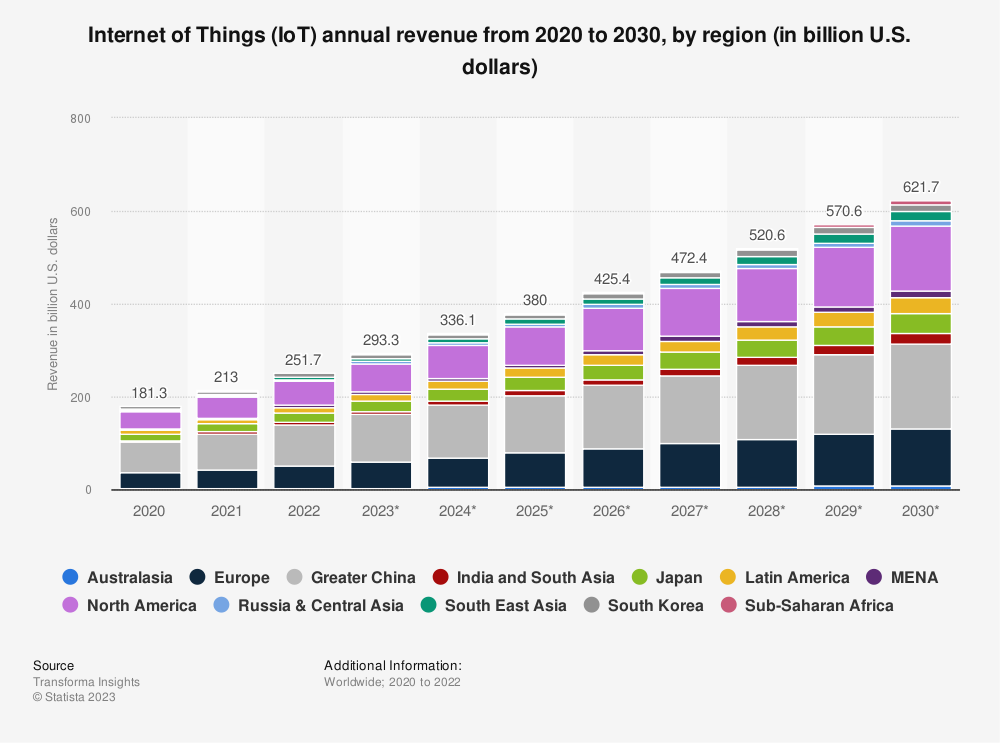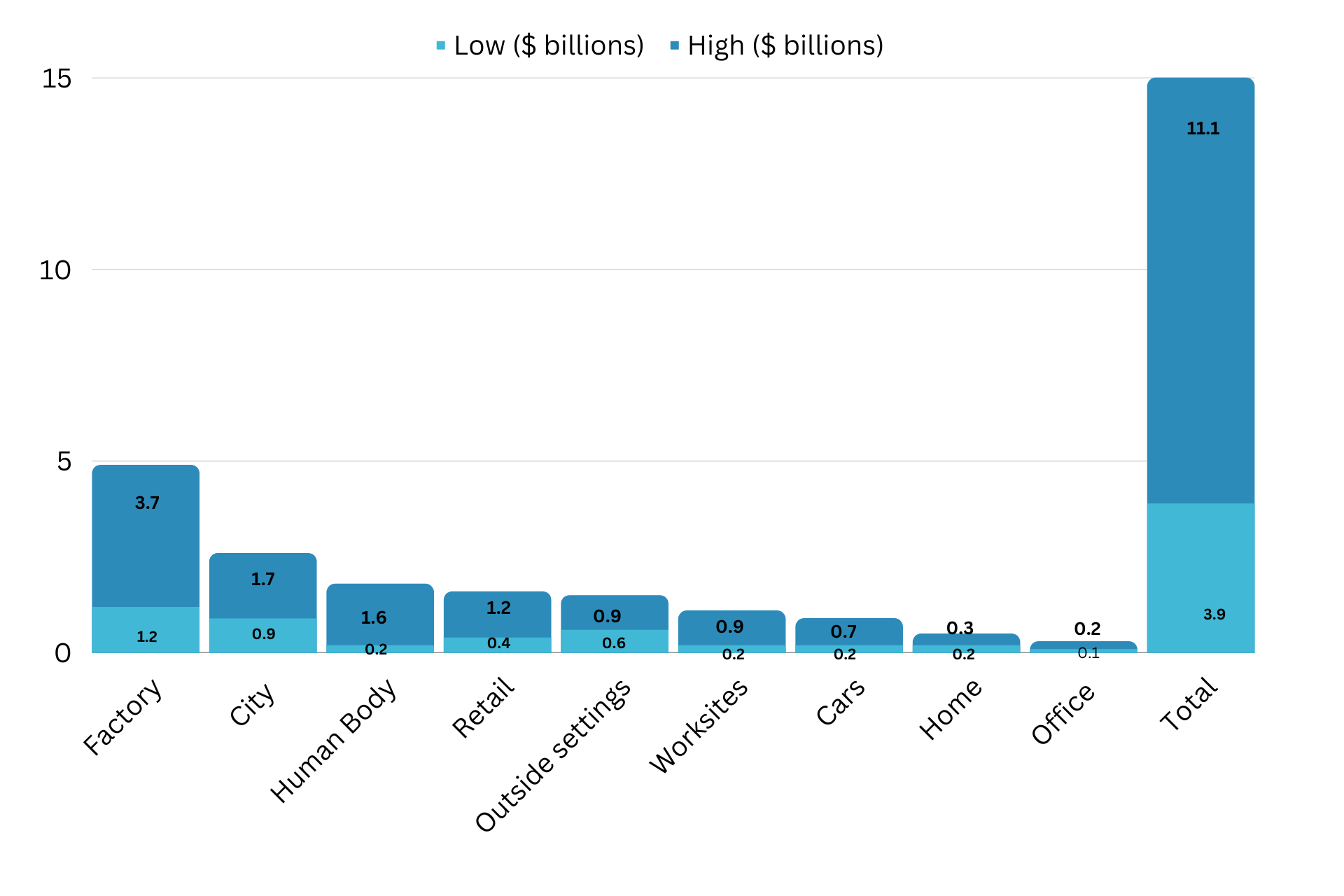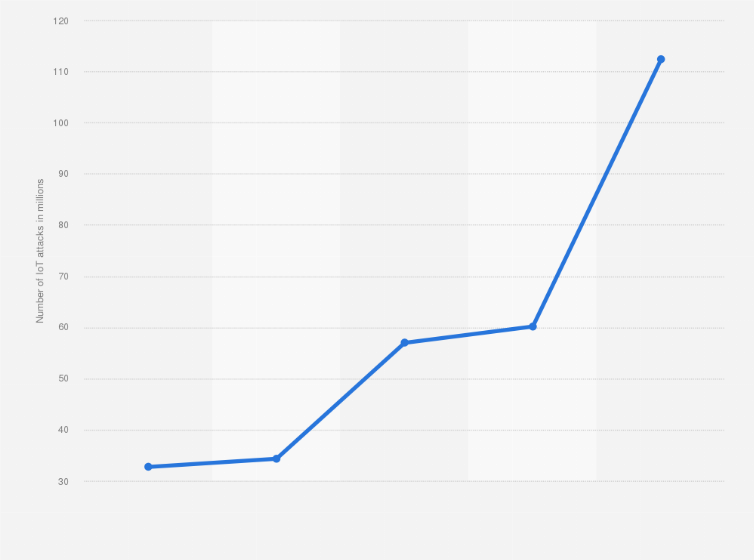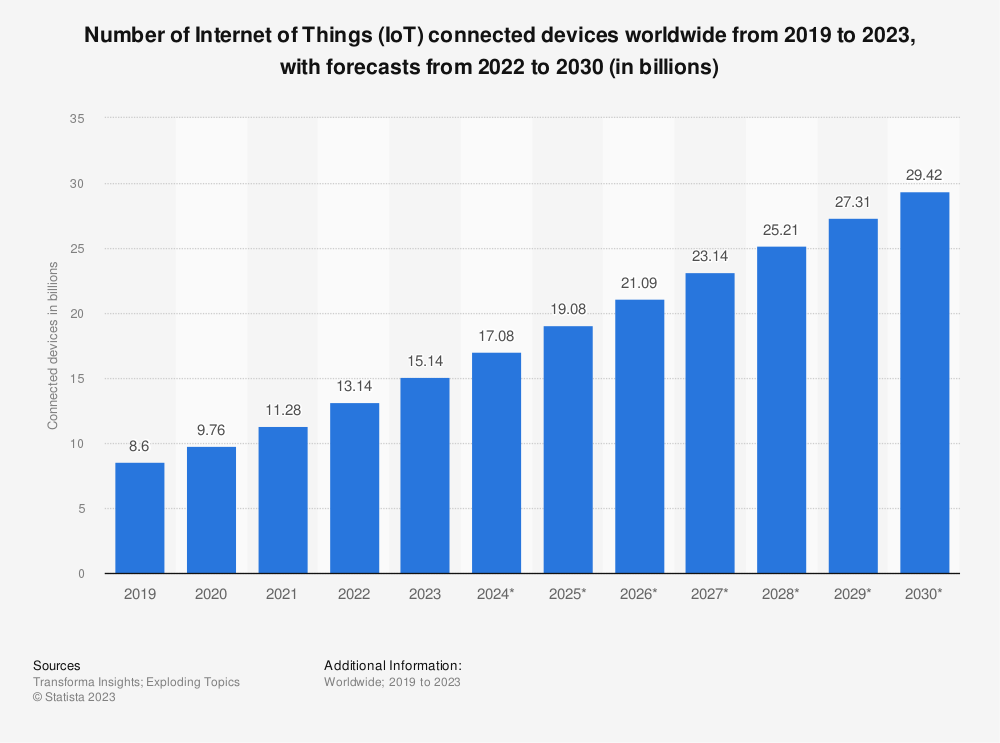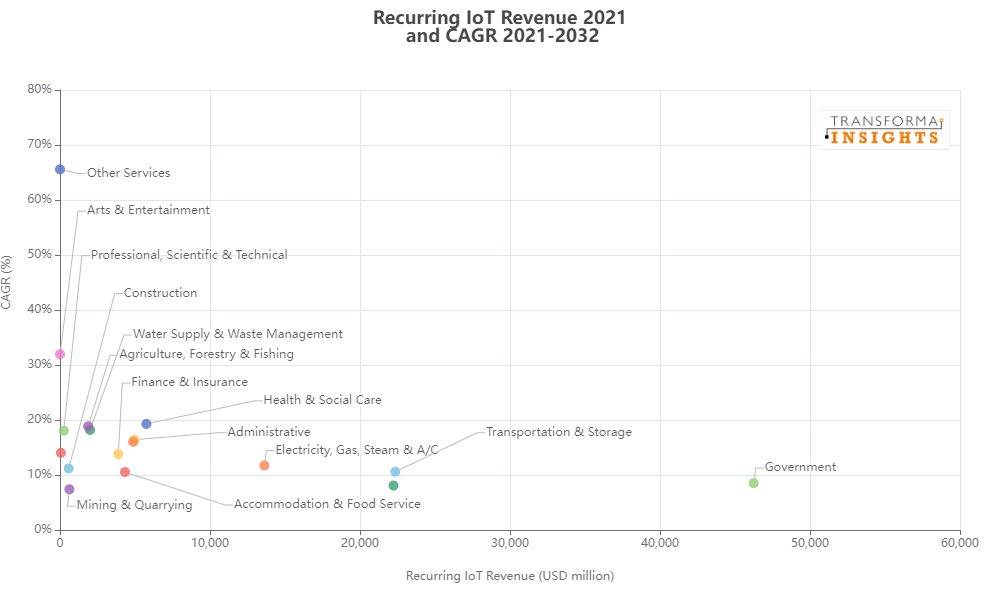IoT Statistics & Facts for 2024 (+ 10 Year Forecast)
The future is here, it's bright, connected & all about data!
9 min. read
Updated on
Read our disclosure page to find out how can you help Windows Report sustain the editorial team Read more
Key notes
- There are over 16.7 billion IoT devices worldwide, and by 2030, the number is forecasted to reach 29 billion.
- Continue reading to learn more such facts and stats!
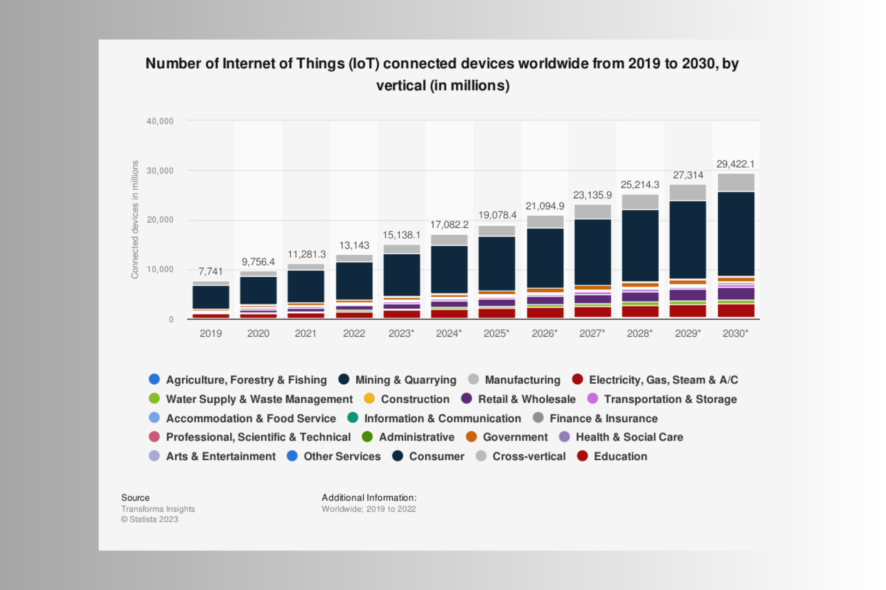
In the fast-evolving digital landscape, the Internet of Things (IoT) has emerged as a metamorphic force, reshaping industries and reinventing how we live and work.
It is still growing astoundingly, opening doors to challenges and opportunities at a large scale. Therefore, it is vital to stay informed and foresee trends shaping the coming years.
In this comprehensive guide, we discuss the latest IoT statistics and facts, highlighting the present scenario and a glimpse of what’s in store.
What are the most common IoT applications?
- Smart home automation – Controls lighting, security cameras, thermostats, and other appliances.
- Healthcare industry– Remote patient monitoring via wearable health devices to track activity levels and other vitals.
- Security & Surveillance – Video surveillance via access control systems for better security.
- Consumer electronics – Connect fitness trackers and smartwatches to gadgets in the home.
- Energy management – Monitors & controls energy consumption in buildings via a smart grid system.
Latest IoT statistics & facts for 2023
- You would be astonished to know the first IoT device was a Coke machine in Pittsburgh, Pennsylvania, which used to report its contents via a network.
- A PWC report shows that 90% of executives believe that the advantages of IoT are far more than the risks involved.
Outdoor surveillance, with USD 7.6 million, is the larget market of IoT.
- The total number of unique smartphones in the second quarter of 2023 was nearly 5.48 billion.
- The Smart Homes Global Market Report 2023 suggests that approximately 69% of US households have at least one smart device, and 15% of the households globally are expected to have a smart home device by the end of 2023.
- The Smart Cities market revenue is projected to reach USD 89.49 billion in 2023. It is anticipated to show a compound annual growth rate of 13.13%, resulting in a market volume of USD 165.80 billion by 2028. Compared to the worldwide figures, the United States, with USD 11.12 billion market revenue in 2023, is expected to lead.
- The top five industries for IoT are manufacturing, Healthcare, Energy, Manufacturing, & Construction, and the leading countries, as of 2023, are the United States, China, Japan, South Korea, & Germany.
London is the smartest city with 46000 tech companies, 240000 jobs in tech companies, & USD 44 billion revenue generated, and is striving to be a carbon-neutral city by 2050.
IoT market size
A report by Statista states that in 2023, Automotive IoT rules the market with a projected market volume of USD 397.20 billion.
The revenue is anticipated to exhibit a compound annual growth rate (CAGR) of 13.60% between 2023-2028, resulting in USD 2,227.00 billion in the total market volume by 2028.
Compared to worldwide figures, the United States would lead the revenue generation with USD $172.30 billion in 2024.
The Enterprise IoT market is anticipated to exhibit a compound annual growth rate of 28.40% during 2022-2030.
The development of advanced technologies like Bluetooth, Insteon, and Wi-Fi drives the growth of the Enterprise IoT market. Also, the increased use of cloud systems for data management is boosting it further.
The North American region is expected to hold the largest market share in the enterprise market; however, underdeveloped countries like Africa and the Middle East might find it challenging to manage the growth.
Regarding IoT spending share, the Asia Pacific region was leading with 37% in 2018 and still maintains the position even after a decrease of 2%. Here are the details:
| Region | 2018 | 2023 |
| Asia Pacific | 37% | 35% |
| North America | 29% | 27% |
| Europe, Middle East, & Africa | 23% | 25% |
| Japan | 9% | 9% |
| Latin America | 9% | 3% |
In the next seven years, by 2030, the annual revenue of consumer internet and media devices is anticipated to be USD 25 billion. Apart from this, we can also expect significant growth in the connected vehicles IoT revenue. Here is the data:
In 2020, the global IoT market was worth approximately USD 182 billion, and by 2030, it is expected to be more than USD 621 billion, which would be triple its revenue in just 10 years.
Also, China is anticipated to lead the Internet of Things market with USD 184 billion by 2030, which would be the 1/3rd of the entire market worldwide, followed by North America with USD 138.7 billion and Europe with USD 122.7 billion.
Retail markets are expected to witness a surge in growth, fueled by more than 21.5% CAGR, attributed to the rising IoT adoption rates.
BusinessWire
IoT growth statistics
A report by Frontier Economics forecasted that the United States GDP will get a boost of 10% in 30 years, all thanks to IoT.
This should not be surprising as the IoT statistics show that IoT is already gaining much attention and disrupting the status quo. Some sectors like energy and agriculture have started to see the advantages of its implementation.
An analysis by McKinsey Global Institute forecasted an overall annual economic impact ranging from $3.9 trillion to $11.1 trillion by 2025 across various sectors, including cities, factories, outside settings, the human body, etc.
The highest estimate of economic impact, including consumer benefits, were to be analyzed; it would be worth 11% of the economy worldwide. Here are the details:
Approximately 127 new devices connect to the Internet every second worldwide.
IoT attacks statistics
In the ever-evolving global digital landscape, our devices are getting smarter, and cybercriminals are becoming sharper by the day.
According to a Statista report, in 2018, the number of cyberattacks related to IoT devices was 32 million; however, in just four years, the number has surged to 112 million in 2022, marking a whopping 87% increase.
The SonicWall Cyber Threat Report, a 2023 mid-year update, mentioned an increase of 37% in IoT malware worldwide, resulting in 77.9 million attacks. The highly affected areas were Asia, with 170%, and Latin America, with 164% increase.
As the rise in the attacks has grown, we must take security measures to keep our IoT devices safe and prevent any mishaps.
IoT devices statistics
According to a report on Statista by Lionel Sujay Vailshery, a research expert for the Consumer Electronics industry, published on July 27, 2023, the number of Internet of Things (IoT) devices is anticipated to double from 15.1 billion in 2020 to more than 29 billion in 2030.
With more than 8 billion consumer devices, China is forecasted as the country with the highest number of IoT devices by 2030.
Consumer IoT devices accounted for a lion’s share of about 60% of all IoT-connected devices in 2020, and the proportion is likely to be the same in the next decade.
One of the popular ways of using IoT devices is via consumer internet & media devices such as smartphones, and by 2030, there are expected to be more than 17 billion of these devices in use.
| Year | IoT Devices (in billions) | Non-IoT Devices (in billions) | Percentage of IoT devices of total devices in use |
| 2010 | 0.8 | 8.0 | 8.8% |
| 2011 | 1.1 | 8.7 | 9.7% |
| 2012 | 1.6 | 9.1 | 10.7% |
| 2013 | 2.1 | 9.5 | 11.6% |
| 2014 | 2.8 | 9.7 | 12.5% |
| 2015 | 3.6 | 9.7 | 13.3% |
| 2016 | 4.6 | 9.8 | 14.4% |
| 2017 | 6.1 | 9.9 | 16.0% |
| 2018 | 8.0 | 9.9 | 17.9% |
| 2019 | 10.0 | 10.0 | 20.0% |
| 2020 | 11.7 | 9.9 | 21.7% |
| 2021 | 13.8 | 10.0 | 23.9% |
| 2022 | 16.4 | 10.1 | 26.5% |
| 2023 | 19.8 | 10.2 | 29.9% |
| 2024 | 24.4 | 10.2 | 34.6% |
| 2025 | 30.9 | 10.3 | 41.2% |
A report by Statista suggests that by 2025, there will be a three-times increase in the use of IoT connected devices in use, i.e, 75 billion.
More than 874 million smart home devices were shipped globally in the third quarter of 2022, with 296 million units; video entertainment devices top the list, followed by security devices and smart speakers. Given the past figures, here are the forecasted estimates for 2023-2027:
| Device Category | 2023 Shipments* | 2023 Market Share* | 2027 Shipments* | 2027 Market Share* | 2023-2027 CAGR* |
| Video Entertainment | 284.4 | 31.9% | 315.4 | 26.5% | 2.6% |
| Home Monitoring/Security | 197.8 | 22.2% | 279.7 | 23.5% | 9.0% |
| Lighting | 111.7 | 12.5% | 243.6 | 20.5% | 21.5% |
| Smart Speaker | 111.7 | 12.5% | 130.9 | 11.0% | 4.0% |
| Thermostat | 25.9 | 2.9% | 31.5 | 2.6% | 5.0% |
| Others | 159.5 | 17.9% | 230.7 | 19.4% | 9.7% |
| Total | 890.9 | 100.0% | 1,231.8 | 100.0% | 8.4% |
If you’re looking for centralized software solutions to manage and monitor IoT devices, read this guide to learn various options.
Industrial Sector
The global market for the Industrial Internet of Things (IIoT) was more than USD 544 billion in 2022, and by 2030, the market is anticipated to grow and reach up to USD 3.3 trillion.
According to PwC survey in 2020, 91% of industrial companies are investing in creating digital factories in the core regions of Europe.
The revenue of IIoT is expected to reach USD 276 billion this year and the United States with USD 66.28 billion, the highest revenue generated would be leading followed by China, Japan, Germany, & India.
Moreover, in the next five years, i.e., 2028, the global revenue is foreseen to show a compound annual growth rate of 13.73%, making it worth USD 525.20 billion.
A digital factory transformation survey 2022 by PwC also mentioned over USD 1.1 trillion of annual investment in factory transformation will be done alone in Europe and Asia.
If you’re looking for an IoT simulator but can’t decide which one to get. read our guide to learn the best options.
Cellular IoT Connections
By the end of 2027, 40% of all cellular connections are anticipated to be IoT-based.
Modor Intelligence
According to a Statista report, the number of cellular IoT connections with broadband worldwide and critical IoT in 2022 was 1.5 billion and will rise to 3.3 billion by 2028.
Ericson Mobility Report in June 2023, North East Asia is at the top in the number of cellular IoT connections. It is anticipated to cross 2 billion connections by the end of 2023.
| IoT | 2022 | 2028 | CAGR |
| Wide-area IoT | 2.9 | 6.0 | 13% |
| Cellular IoT | 2.7 | 5.4 | 12% |
| Short-range IoT | 10.2 | 28.7 | 19% |
| Total | 13.2 | 34.7 | 18% |
Here are details of the cellular IoT connections by segment and technology from 2018-2028:
5G is the next-gen of cellular technology, providing faster and lower latency results than its predecessor. By the end of 2024, the number of 5G cellular subscriptions will reach 1.9 billion.
IoT 10-year forecast
The cellular-connected IoT devices installed base is forecasted to grow to approximately 5 billion by 2030.
| Year | 2021 | 2022 | 2023 | 2024 | 2025 | 2026 | 2027 | 2028 | 2029 | 2030 | 2031 | 2032 |
| 5G mMTC* | 0.29 | 0.44 | 0.60 | 0.78 | 1.01 | 1.27 | 1.57 | 1.91 | 2.27 | 2.67 | 3.09 | 3.54 |
| 5G non-mMTC | 0.01 | 0.02 | 0.03 | 0.05 | 0.08 | 0.12 | 0.18 | 0.26 | 0.37 | 0.49 | 0.64 | 0.81 |
| 4G | 0.61 | 0.76 | 0.91 | 1.06 | 1.22 | 1.36 | 1.48 | 1.58 | 1.66 | 1.72 | 1.75 | 1.76 |
| 3G | 0.08 | 0.02 | 0.01 | 0.01 | 0.00 | 0.00 | 0.00 | 0.00 | 0.00 | 0.00 | 0.00 | 0.00 |
| 2G | 0.27 | 0.31 | 0.29 | 0.26 | 0.23 | 0.19 | 0.16 | 0.14 | 0.11 | 0.09 | 0.08 | 0.07 |
The Consumer market is forecasted to lead in 2030, driven mainly by smartwatches, headphones, smart speakers, and connected TVs.
Whereas the vertical-specific market is broken into small fragments, smart metering will significantly impact all.
Cross-vertical or Enterprise markets encompass apps across different industries, such as ventilation, connected healing, AC systems, and connected security systems.
| Enterprise | Greater China | Europe | North America | Japan | Latin America | South East Asia | MENA | India & South Asia | Russia & Central Asia | South Korea | Australasia | Sub-Saharan Africa |
| Vertical-specific | 2.58 | 2.23 | 1.97 | 0.63 | 0.49 | 0.35 | 0.30 | 0.28 | 0.21 | 0.14 | 0.14 | 0.17 |
| Cross-vertical | 1.32 | 0.79 | 0.83 | 0.25 | 0.21 | 0.13 | 0.12 | 0.13 | 0.08 | 0.09 | 0.06 | 0.05 |
| Consumer | 5.95 | 4.71 | 4.57 | 1.29 | 1.13 | 0.76 | 0.60 | 0.59 | 0.47 | 0.46 | 0.31 | 0.16 |
The graph below shows the IoT revenues in different enterprise sectors, depicting that Government, Retail & wholesale, and Transportation & storage have significant revenue opportunities even though their growth rates are lower than others.
If you want to look at more details, check this table:
| Sectors | Revenue in 2021 (million) | Compound Annual Growth Rate (by 2032) |
| Arts & Entertainment | 4.3 | 32% |
| Professional, Scientific & Technical | 253.6 | 18.1% |
| Construction | 581.4 | 11.2% |
| Water Supply & Waste Management | 2001.5 | 18.2% |
| Agriculture, Forestry & Fishing | 1876.3 | 18.9% |
| Finance & Insurance | 3886.3 | 13.8% |
| Health & Social Care | 5758.2 | 19.3% |
| Administrative | 4969 | 16.4% |
| Electricity, Gas, Steam & A/C | 13628.5 | 11.7% |
| Mining & Quarrying | 627.1 | 7.4% |
| Accommodation & Food Service | 4329.8 | 10.5% |
| Transportation & Storage | 22354.8 | 10.6% |
| Government | 46243 | 8.5% |
| Other Services | 0.1 | 65.6% |
To conclude, the insights from the latest IoT statistics depict how it has created and will continue to create a substantial economic impact worldwide in the next decade.
Although inclusion in various industries has boosted their revenues at folds, the increased number of attacks due to IoT devices can also not be neglected.
Therefore, even though the data collected and reports presented paint a promising picture of IoT technology’s future, it is important to remain vigilant and informed.
What do you think about IoT? Don’t hesitate to mention your thoughts in the comments section below.


